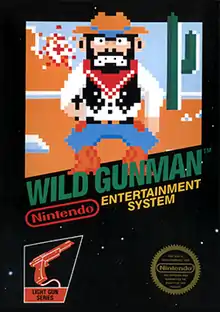Wild Gunman
Wild Gunman[lower-alpha 1] is a light gun shooter game created by Nintendo. Originally created as an electro-mechanical arcade game in 1974 by Gunpei Yokoi, it was adapted to a video game format on an arcade cabinet and light gun. It was released in 1985 as a launch game for the Nintendo Entertainment System with the Zapper light gun.
| Wild Gunman | |
|---|---|
 Package of Nintendo Entertainment System version | |
| Developer(s) | Nintendo Intelligent Systems |
| Publisher(s) | Nintendo |
| Producer(s) | Hiroshi Imanishi Shigeru Miyamoto |
| Composer(s) | Hirokazu Tanaka |
| Platform(s) | Famicom/NES Arcade PlayChoice-10 |
| Release | |
| Genre(s) | Light gun game |
| Mode(s) | Single-player |
Original version
The original version of Wild Gunman is one of Nintendo's electro-mechanical arcade games created by Gunpei Yokoi and released in 1974. It consists of a light gun connected to a 16 mm projection screen. Full-motion video footage of an American Wild West gunslinger is projected onto the screen. When this enemy character's eyes flash, the player draws and fires the gun. If the player is fast enough, the projection changes to that of the shot gunman falling down; otherwise it shows the gunman drawing and firing his gun. A victorious player faces off against several more gunslinger opponents.[1] This version of Wild Gunman was released in North America by Sega in 1976.[2]
The second version has a plastic gunman figure mounted on top of a plastic battery box called Custom Gunman, which later became one of the microgames in the Game Boy Advance title WarioWare, Inc.: Mega Microgames!.
Video game versions

Nintendo converted the electro-mechanical concept into a video game, replacing photographic images with cartoon-style sprites.
In 1984 in Japan, the Famicom version was released for use with the Zapper gun peripheral. This was also available packaged with a plastic, western-style revolver accessory (modeled after the Colt Single Action Army) that can be used instead of the Zapper. In 1985 in the United States, it was released on the Nintendo Entertainment System.
In the NES version, the player waits for the opponent's eyes to flash (accompanied by a speech bubble reading "FIRE!!") before shooting. It features a shooting gallery where opponents are to be shot from the windows of a saloon. A piece of Frédéric Chopin's "Funeral march" indicates the player's defeat. This version was also published on the PlayChoice-10 arcade system. On the Wii U Virtual Console, the Wii Remote pointer is used instead of the Zapper.
In popular culture
Experimental filmmaker Craig Baldwin's 1978 short Wild Gunman features footage from the original 1974 arcade game which was re-edited, sped up, and slowed down to surreal effect.[3]
In the 1989 film Back to the Future Part II, protagonist Marty McFly plays a non-existent arcade version of the NES Wild Gunman resembling a Nintendo VS. System cabinet. The 1990 follow-up, Part III, reveals that frequently playing the game has given Marty the skill to shoot a real revolver. Nintendo re-released the game to the Wii U Virtual Console on October 21, 2015 to coincide with Back to the Future Day, honoring the game's appearance in the film.[4][5]
In the Super Smash Bros. series, the Duck Hunt duo can summon Wild Gunman characters to attack their opponents. Their "Final Smash" attack causes opponents to get caught in the middle of a shootout between the gunmen and the enemy characters from Hogan's Alley.
See also
References
- Wild Gunman (1974) at the Killer List of Videogames
- "SEGA Introduces Two New Games" (PDF). Cashbox. April 24, 1976. Retrieved December 10, 2019.
- "Craig Baldwin". Hi-beam.net. Retrieved April 9, 2016.
- Kohler, Chris (October 21, 2015). "Nintendo Re-Releases Marty McFly's Favorite Game This Week". Wired. Retrieved October 21, 2015.
- Fingas, Jon (September 21, 2015). "Nintendo revives 'Wild Gunman' in time for 'Back to the Future' Day". Engadget. Retrieved December 10, 2019.
External links
- Wild Gunman series at NinDB
- Wild Gunman Arcade Prop Replica at KLOV
- Front and Back side of the flyer of the original 1974 Wild Gunman movie game (from Arcade Flyer Archive) as well as two pictures #1 and #2 of this version (from an AOL member homepage).